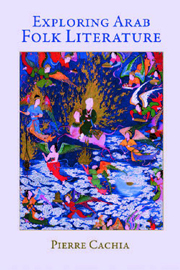Book contents
- Frontmatter
- Contents
- Acknowledgements
- Dedication
- Foreword by Professor Clive Holes
- Introduction
- The Transcription of Both Classical and Colloquial Arabic
- Part 1 Fact Finding
- 1 Arabic Literatures, ‘Elite’ and ‘Folk’ – Junctions and Disjunctions Quaderni di Studi Arabi, Nuova serie, 3 (2008)
- 2 The Egyptian Mawwāl: Its Ancestry, its Development, and its Present Forms Journal of Arabic Literature, 8 (1977)
- 3 The Nahḍa‘s First Stirrings of Interest in Alf Layla (previously unpublished).
- 4 The Career of Muṣṭafā > Ibrāhīm < Ajāj: A Giant of Egyptian Popular Literature Across Cultures, ed. Daniel Massa (Valletta, Malta, 1977)
- Part 2 Single or Related Items
- Part 3 Cultural and Social Implications
1 - Arabic Literatures, ‘Elite’ and ‘Folk’ – Junctions and Disjunctions Quaderni di Studi Arabi, Nuova serie, 3 (2008)
from Part 1 - Fact Finding
Published online by Cambridge University Press: 05 February 2015
- Frontmatter
- Contents
- Acknowledgements
- Dedication
- Foreword by Professor Clive Holes
- Introduction
- The Transcription of Both Classical and Colloquial Arabic
- Part 1 Fact Finding
- 1 Arabic Literatures, ‘Elite’ and ‘Folk’ – Junctions and Disjunctions Quaderni di Studi Arabi, Nuova serie, 3 (2008)
- 2 The Egyptian Mawwāl: Its Ancestry, its Development, and its Present Forms Journal of Arabic Literature, 8 (1977)
- 3 The Nahḍa‘s First Stirrings of Interest in Alf Layla (previously unpublished).
- 4 The Career of Muṣṭafā > Ibrāhīm Across Cultures, ed. Daniel Massa (Valletta, Malta, 1977)
- Part 2 Single or Related Items
- Part 3 Cultural and Social Implications
Summary
The pre-Islamic Arab's strongest loyalty was to a tribe. This was essential to his everyday concerns; but already before Islam he was aware that he and his fellow tribesmen were part of a wider entity. What was the mainstay of this entity? It was not a geographic unit: there is no single word for Arabia in Arabic; instead, one speaks of bilād al-<arab, ‘the settlements (in the plural) of the Arabs’. If not territory, what? Ethnicity, no doubt, as is indicated by the fact that not only tribes but also some tribal groups claimed a common forefather. But I hold the view – which I admit is not widely shared by my colleagues – that, to a larger extent than is true of other peoples, language has been and remains a key constituent of the Arabs' self-view and self-esteem. My evidence is that when they spoke of their ancestry, the Arabs distinguished between the ‘Arabiser’ and the ‘Arabised’ Arabs (al-<arab al-<āribah and al-<arab al-musta<ribah), terms that, when used in conjunction have virtually always been glossed as denoting a linguistic process. Furthermore, most of the commonly used derivatives from the <-r-b root denote expressiveness, even when speech is not involved, as when a woman displaying affection for her husband is said to be <arūb. In contrast <ajam, the word that pre-Islamic Arabs used for ‘foreigners’ or more specifically ‘Persians’, comes from a root the primary sense of which is ‘to chew’, presumably implying that they seem to chew their words, and most of the other derivatives from <-j-m carry the sense of ‘indistinctiveness’, or ‘obscurity’.
- Type
- Chapter
- Information
- Exploring Arab Folk Literature , pp. 3 - 18Publisher: Edinburgh University PressPrint publication year: 2011



